Do you have a question about the Porter-Cable CPFAC2600P and is the answer not in the manual?
Identifies the location of the model and serial number plate on the compressor for record-keeping.
Explains the meaning of DANGER, WARNING, and CAUTION symbols used in the manual.
Details the risks associated with fire and explosion, and how to prevent them.
Outlines conditions that can weaken the air tank and lead to rupture or explosion.
Describes hazards from compressed air streams and how to prevent injury.
Covers electrical hazards, proper grounding, and repair safety.
Warns against breathing compressed air and advises on safe usage for sprayed materials.
Advises on avoiding contact with hot compressor parts during or after operation.
Warns about injury from moving components and the importance of guards.
Details risks associated with compressor instability and falling.
Addresses hazards related to oil leaks and damage during compressor transport.
Provides general safety advice for operating the compressor safely.
Lists technical details such as bore, stroke, voltage, and pressure ratings.
Defines key terms like SCFM, PSIG, Cut-In Pressure, and Cut-Out Pressure.
Advises on optimal running times to prolong compressor life.
Instructions for removing the compressor from its packaging.
Guidance on locating and positioning the compressor for optimal operation.
Critical steps for ensuring proper electrical grounding to prevent shock.
Recommendations and requirements for using extension cords with the compressor.
Details on circuit requirements, fuse types, and protection for the compressor.
Familiarization with the compressor's main components and controls.
Detailed explanation of the function of the On/Off switch, gauges, regulator, and valves.
Explains the function and location of the drain and check valves.
Simple steps to turn off the compressor after use.
Essential steps to prepare the compressor for its first use to ensure longevity.
Pre-operation checks and settings required before starting the compressor.
Outlines regular maintenance tasks the user must perform.
Procedure for testing the safety valve to ensure proper operation.
Step-by-step guide for draining condensation from the air tank.
Instructions for removing, cleaning, or replacing the check valve.
Detailed steps for removing and installing a new regulator assembly.
Procedures to follow before storing the air compressor to prevent damage.
Addresses problems like excessive pressure pop-off, fitting leaks, and tank leaks.
Covers knocking noise and air leaks from the safety valve or seals.
Diagnoses problems with pressure drop, insufficient air output, or hose issues.
Troubleshooting continuous air leaks from the regulator knob.
Identifies causes and corrections for the motor failing to start or run.
Details the warranty duration for different compressor components and accessories.
Outlines what the original purchaser must do to process a warranty claim.
Lists conditions and circumstances not covered by the limited warranty.
Identifies the location of the model and serial number plate on the compressor for record-keeping.
Explains the meaning of DANGER, WARNING, and CAUTION symbols used in the manual.
Details the risks associated with fire and explosion, and how to prevent them.
Outlines conditions that can weaken the air tank and lead to rupture or explosion.
Describes hazards from compressed air streams and how to prevent injury.
Covers electrical hazards, proper grounding, and repair safety.
Warns against breathing compressed air and advises on safe usage for sprayed materials.
Advises on avoiding contact with hot compressor parts during or after operation.
Warns about injury from moving components and the importance of guards.
Details risks associated with compressor instability and falling.
Addresses hazards related to oil leaks and damage during compressor transport.
Provides general safety advice for operating the compressor safely.
Lists technical details such as bore, stroke, voltage, and pressure ratings.
Defines key terms like SCFM, PSIG, Cut-In Pressure, and Cut-Out Pressure.
Advises on optimal running times to prolong compressor life.
Instructions for removing the compressor from its packaging.
Guidance on locating and positioning the compressor for optimal operation.
Critical steps for ensuring proper electrical grounding to prevent shock.
Recommendations and requirements for using extension cords with the compressor.
Details on circuit requirements, fuse types, and protection for the compressor.
Familiarization with the compressor's main components and controls.
Detailed explanation of the function of the On/Off switch, gauges, regulator, and valves.
Explains the function and location of the drain and check valves.
Simple steps to turn off the compressor after use.
Essential steps to prepare the compressor for its first use to ensure longevity.
Pre-operation checks and settings required before starting the compressor.
Outlines regular maintenance tasks the user must perform.
Procedure for testing the safety valve to ensure proper operation.
Step-by-step guide for draining condensation from the air tank.
Instructions for removing, cleaning, or replacing the check valve.
Detailed steps for removing and installing a new regulator assembly.
Procedures to follow before storing the air compressor to prevent damage.
Addresses problems like excessive pressure pop-off, fitting leaks, and tank leaks.
Covers knocking noise and air leaks from the safety valve or seals.
Diagnoses problems with pressure drop, insufficient air output, or hose issues.
Troubleshooting continuous air leaks from the regulator knob.
Identifies causes and corrections for the motor failing to start or run.
Details the warranty duration for different compressor components and accessories.
Outlines what the original purchaser must do to process a warranty claim.
Lists conditions and circumstances not covered by the limited warranty.
| Model | CPFAC2600P |
|---|---|
| Type | Portable |
| Max Pressure | 150 PSI |
| Tank Capacity | 6 Gallons |
| Power Source | Electric |
| CFM @ 90 PSI | 2.6 CFM |
| Pump Type | Oil-Free |
| Voltage | 120 V |
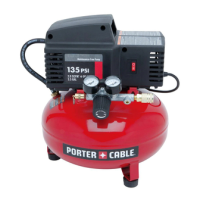
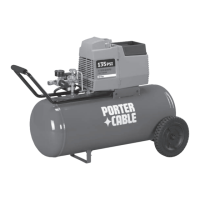
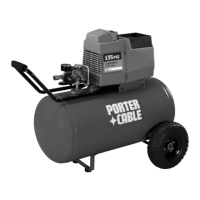
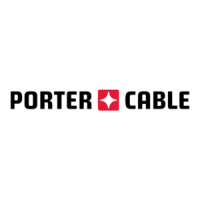
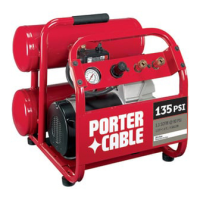
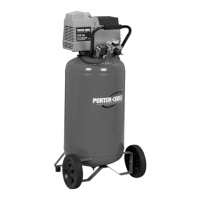


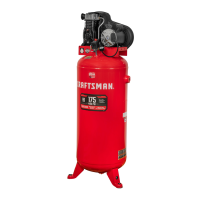
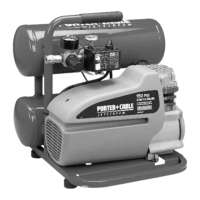
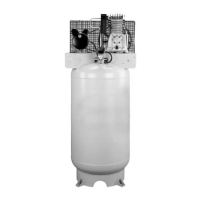
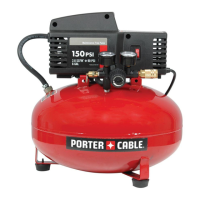
